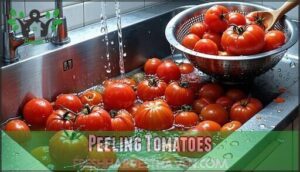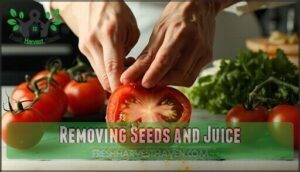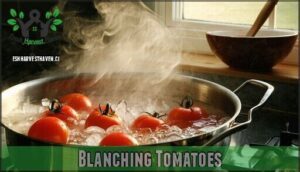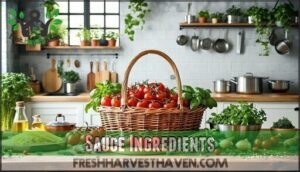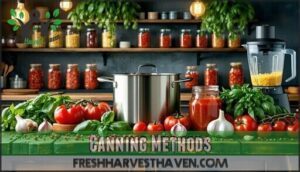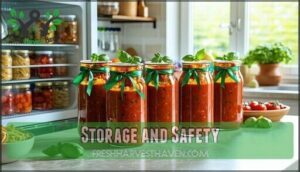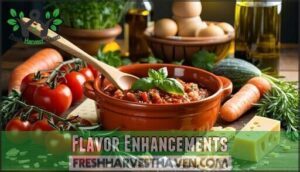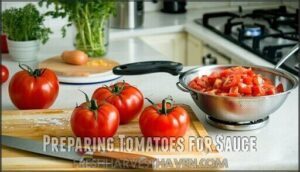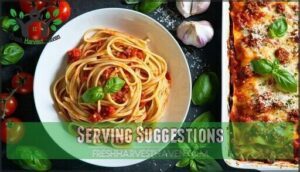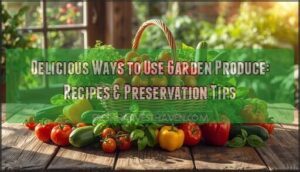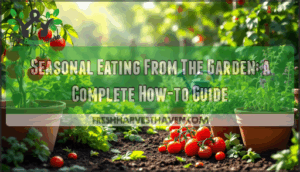This site is supported by our readers. We may earn a commission, at no cost to you, if you purchase through links.
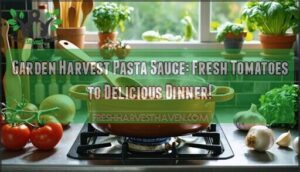 Transform your garden’s summer bounty into rich, flavorful garden harvest pasta sauce that’ll make your kitchen smell like an Italian grandmother’s dream. Start with fresh Roma or San Marzano tomatoes at peak ripeness—they’re meaty with balanced acidity that creates the perfect base.
Transform your garden’s summer bounty into rich, flavorful garden harvest pasta sauce that’ll make your kitchen smell like an Italian grandmother’s dream. Start with fresh Roma or San Marzano tomatoes at peak ripeness—they’re meaty with balanced acidity that creates the perfect base.
Sauté onions and garlic in olive oil until fragrant, then add your prepared tomatoes and simmer for 30-45 minutes to concentrate those bright flavors. Season with fresh basil, oregano, salt, and pepper to taste. The key is letting the sauce reduce slowly, stirring occasionally until it reaches that perfect consistency that coats pasta beautifully.
Your homegrown tomatoes hold secrets to achieving restaurant-quality results right from your own backyard.
Table Of Contents
- Key Takeaways
- Making Pasta Sauce
- Tomato Preparation
- Sauce Ingredients
- Cooking Techniques
- Canning Methods
- Storage and Safety
- Flavor Enhancements
- Harvesting Tomatoes
- Serving Suggestions
- Frequently Asked Questions (FAQs)
- How to make spaghetti sauce with garden tomatoes?
- What is garden fresh tomato pasta sauce?
- Which tomatoes are best for spaghetti sauce?
- How do you make homemade spaghetti sauce?
- What is the best off the shelf spaghetti sauce?
- What pasta sauce does Bobby Flay use?
- What are the ingredients in Trader Joe’s harvest sauce?
- How to use American Garden mushroom pasta sauce?
- Can I use cherry tomatoes for sauce?
- How long does homemade sauce last refrigerated?
- Conclusion
Key Takeaways
- Choose paste tomatoes like Roma or San Marzano – They’re meaty with less water content, creating a rich, concentrated sauce that won’t turn watery like cherry or slicing tomatoes.
- Master the blanching technique – Drop ripe tomatoes in boiling water for 30 seconds, then plunge into ice water to make peeling effortless and remove bitter skins.
- Simmer slowly for 30-45 minutes uncovered – This reduces excess moisture and concentrates flavors, creating that perfect consistency that coats pasta beautifully.
- Store properly for year-round enjoyment – Use pressure canning methods for shelf-stable jars or freeze in portions, ensuring you’ll have garden-fresh sauce all winter long.
Making Pasta Sauce
You’ll transform fresh garden tomatoes into rich, flavorful pasta sauce that beats any store-bought version. The process involves selecting the right tomatoes, preparing them properly, and cooking them down into a delicious base for countless meals.
Choosing Fresh Tomatoes
When you’re ready to transform garden tomatoes into sauce magic, your variety choice makes all the difference. Skip watery slicers and reach for paste tomatoes like Roma or San Marzano—they’ll give you that rich, concentrated flavor you’re craving.
Garden tomatoes hold the secret to sauce that beats any store-bought version
Here’s your tomato selection roadmap:
- Test for ripeness – Look for deep color and gentle give when pressed
- Choose paste varieties – Roma and San Marzano offer meaty texture with less water
- Add heirloom tomatoes – Mix in Cherokee Purples or Brandywines for complex flavor profiles
- Source organically – Organic tomatoes deliver pure taste without chemical residues
- Harvest at peak – Morning picking captures maximum flavor before heat stress
Fresh tomato selection starts with understanding tomato ripening signs. The right tomatoes smell sweet at the stem end and yield slightly to pressure. Garden tomato harvesting timing affects your sauce’s final taste—pick them when they’re fully colored but still firm for the best tomato flavor profiles. For ideal results, consider growing heat resistant tomatoes to guarantee a bountiful harvest.
Preparing Tomato Ingredients
Your fresh garden tomatoes deserve proper preparation to reveal their full potential. Start by washing tomato varieties under cool running water.
Tomato blanching transforms tough skins—drop ripe tomatoes in boiling water for thirty seconds, then plunge into ice water. Peeling becomes straightforward as skins slip right off.
Seed removal and juice extraction prevent watery sauce, while tomato chopping creates uniform pieces.
This careful preparing tomatoes process delivers maximum flavor enhancement for your homemade sauce.
Cooking Tomato Sauce
Heat transforms your fresh tomatoes into liquid gold through proper cooking techniques. Start by sautéing onions until translucent, then add garlic.
Here’s your step-by-step process:
- Tomato blanching – Add prepared tomatoes to your aromatic base
- Sauce reduction – Simmer uncovered for 30-45 minutes, stirring occasionally
- Flavor improvement – Taste and adjust seasoning throughout cooking
- Acid balance – Add lemon juice if needed for brightness
- Consistency check – Continue simmering until your homemade pasta sauce reaches desired thickness
Watch the magic happen as your cooking spaghetti sauce concentrates, developing rich tomato flavor.
Tomato Preparation
Perfect tomato prep turns garden-fresh fruit into silky sauce gold. You’ll blanch, peel, and seed your tomatoes to create the smoothest base for your harvest sauce.
Peeling Tomatoes
Those perfectly plump garden tomatoes won’t surrender their skins without a fight, but there’s a simple trick that’ll have you peeling like a pro. The secret lies in understanding tomato skin removal through proper blanching techniques.
You don’t need fancy peeling tools – just boiling water and an ice bath. This fresh tomato preparation method softens the skin connection without cooking the flesh, making skin separation methods incredibly effective.
Here’s your step-by-step approach:
- Score a shallow X on each tomato’s bottom with a sharp knife
- Drop into rapidly boiling water for 30-60 seconds until skins start loosening
- Plunge immediately into ice water to halt the cooking process
- Peel away the loosened skins starting from your scored mark
The blanching process transforms stubborn skins into slip-off wrappers. You’ll hear that satisfying pop as the skin separates from the flesh – it’s like unwrapping nature’s gift.
Save those peels for composting or dry them for homemade tomato powder. Your future tomato sauce and canning projects will thank you for this smooth foundation.
Removing Seeds and Juice
Properly removing seeds and excess juice from your fresh garden tomatoes creates the foundation for rich, concentrated flavor improvement. This seed removal technique prevents bitter flavors and watery consistency in your garden harvest sauce.
Cut Roma tomatoes in half crosswise, then gently squeeze out watery pulp and tomato seeds using your thumb or spoon.
Method Best For
Blanching Tomatoes
You’ll transform your garden tomatoes into silky homemade pasta sauce through tomato blanching. This process perfectly readies your tomato sauce for canning later.
Drop ripe tomatoes into rapidly boiling water temperature for thirty seconds to one minute, adjusting blanching time based on ripeness. The heat shock method makes tomato skinning straightforward. Immediately plunge them into ice water to stop cooking.
Sauce Ingredients
You’ll need the right blend of seasonings and aromatics to transform your fresh tomatoes into restaurant-quality sauce. The perfect combination starts with quality olive oil, fresh garlic, and a careful balance of herbs that’ll make your kitchen smell like an Italian grandmother’s cooking.
Essential Herbs and Spices
Beyond the rich tomato base, you’ll discover that herbs and spices breathe life into your sauce. Basil Usage centers on its sweet, peppery essence that pairs naturally with fresh tomatoes. Oregano Benefits include earthy depth that anchors Mediterranean flavors. Garlic Flavor adds aromatic warmth, while black pepper provides subtle heat. Spice Blending creates complexity through careful combinations. The choice of basil can substantially impact the flavor, considering the various basil leaf options.
- Fresh basil: Add during final minutes to preserve bright, sweet notes
- Dried oregano: Incorporates early for deeper, earthier flavor development
- Fresh parsley: Brightens the sauce with clean, grassy undertones
- Herbal Infusion: Layer herbs at different cooking stages for complex taste
Olive Oil and Garlic
Heat olive oil gently in your pan—this preserves those precious aromatic compounds that make your homemade pasta sauce shine. Add minced garlic once the oil shimmers, releasing fragrant oils that form your flavor foundation.
This garlic infusion creates the perfect base, delivering olive oil benefits and flavor enhancement that transforms simple garden harvest ingredients into restaurant-quality sauce through smart culinary uses.
Salt and Pepper
Salt types matter more than you think. Sea salt and kosher salt deliver cleaner flavor enhancement than table salt. Add salt early to pull moisture from tomatoes. Freshly ground black pepper beats pre-ground versions every time. Red pepper flakes add welcome heat.
Taste throughout cooking—your seasoning tips and spice blending create perfect balance. Using the right ingredients is key to a great dish, especially when considering healthy eating options.
Cooking Techniques
Once you master these essential cooking techniques, you’ll transform fresh garden tomatoes into rich, flavorful sauce that rivals any store-bought version. The key lies in proper sautéing, patient simmering, and skillful reduction to concentrate those bright summer flavors.
Sautéing Onions and Garlic
Foundation is key when building aromatic flavor in your homemade pasta sauce. Sauté chopped onions in olive oil for 5-7 minutes until they become caramelized onions with golden sweetness. Add minced garlic and stir constantly for one minute, creating a perfect garlic infusion.
These essential sauté techniques prevent burning while delivering maximum flavor enhancement for your garden harvest pasta sauce. To intensify the flavor, using a garlic press tool can help release the full potential of garlic in your sauce.
Simmering Tomato Sauce
Gentle bubbling transforms your garden tomatoes into liquid gold. Once you’ve added your prepped tomatoes to the sautéed onions and garlic, bring everything to a gentle simmer. This vital step requires patience – you’re not rushing dinner, you’re crafting flavor.
Heat Control matters here. Keep that simmer steady and low. Your homemade pasta sauce shouldn’t be violently boiling like a science experiment gone wrong.
Master these Simmering Techniques for perfect results:
- Maintain gentle bubbles that barely break the surface
- Stir every 5-7 minutes to prevent sticking and scorching
- Keep the pot partially uncovered for proper evaporation
- Let garden tomatoes cook for 20-30 minutes minimum
Flavor Enhancement happens during this magical time. The tomato sauce concentrates, deepens, and develops that rich taste you can’t buy in stores. Sauce Thickening occurs naturally through Tomato Reduction – no shortcuts needed, just time and proper technique.
Reducing Sauce Thickness
Mastering sauce reduction transforms your homemade pasta sauce into restaurant-quality excellence. Control thickness through strategic evaporation methods and careful simmering times. Understanding thickening pasta techniques is also essential for achieving the right consistency.
Here’s your reduction roadmap:
- Simmer uncovered – promotes faster evaporation and flavor concentration
- Add tomato paste gradually – thickening agents work better in small amounts
- Use immersion blender sparingly – creates smoother texture without overdoing consistency
Perfect pasta sauce develops through patient reducing and attentive stirring.
Canning Methods
You’ve worked hard to create that perfect garden harvest pasta sauce, and proper canning guarantees you’ll enjoy those summer flavors all year long.
The key to safe canning lies in sterilizing your equipment and following tested pressure canning methods to preserve your sauce without compromising quality or safety.
Sterilizing Jars and Equipment
Before you fill those precious jars with your garden harvest pasta sauce, proper sterilization protects your hard work. Start with hot soapy water to wash all canning jars and equipment thoroughly.
Submerge clean jars in boiling water for ten minutes—add one minute per 1,000 feet of altitude. Keep sterilized jars hot until filling time. Use a jar lifter for safe handling.
These hygiene practices prevent contamination and guarantee your canning safety.
Filling and Sealing Jars
With your sterilized jars ready, you’re set to capture summer’s bounty. Hot pasta sauce goes straight from pot to jar—no cooling needed. Ladle carefully, keeping that half-inch headspace for proper vacuum sealing. Think of it as giving your Homemade Pasta Sauce room to breathe.
Air bubbles lurk like tiny troublemakers, so slide a plastic spatula around jar edges to release them. Clean jar rims with a damp cloth—even tiny sauce specks cause sealing problems. Place warm lids centered on jars, then twist bands fingertip-tight only.
Your canning spaghetti sauce success depends on these details:
- Headspace Importance: Measure that half-inch gap religiously—too much or too little prevents proper sealing.
- Jar Size: Standard mason jars work best for consistent processing times.
- Lid Types: Use new lids every time for reliable sealing.
- Safe Handling: Keep everything hot to prevent thermal shock during Pasta Sauce Canning.
Processing Jars in Pressure Canner
Load your sealed jars into the pressure canner with 2-3 inches of hot water. Secure the lid and bring to a rolling boil, then process at 10 PSI for 25 minutes following proper Canning Schedules.
Altitude Adjustments require higher pressure—check your elevation for Canner Safety Tips. Don’t lift the lid during pressure canning methods or you’ll restart the timing.
Proper Pressure Gauge Calibration guarantees safe Pasta Sauce Canning results.
Storage and Safety
After you’ve made your garden harvest pasta sauce, proper storage keeps it fresh and safe to eat. Cool your sauce completely before freezing in meal-sized portions, and always check that your canned jars have sealed properly before storing them in a cool, dark place.
Cooling and Freezing Sauce
Once your canned sauce finishes processing, you’ll want to explore freezer storage options that’ll keep your garden bounty fresh all winter long. Flash freezing works perfectly for homemade sauce – just cool it completely before transferring to freezer-safe containers.
Your freezer spaghetti sauce stays delicious for months when stored properly. Remove excess air from freezer containers to prevent that dreaded freezer burn taste. Glass jars work great, but leave headspace for expansion.
- Flash freezing tip: Spread sauce on baking sheets first, then transfer to freezer bag portions
- Sauce cooling method: Cool completely at room temperature before refrigerating, then freeze
- Freezer friendly containers: Use wide-mouth jars or plastic containers with tight-fitting lids
- Thawing methods: Refrigerate overnight or submerge sealed containers in cold water
- Frozen shelf-life: Label everything with dates – quality stays peak for 8-10 months
Checking Jar Seals and Storage
Once the cooling process is complete, you’ll hear that telltale "pop" sound – your reward for proper canning technique. Now comes the vital jar inspection phase that determines your food preservation success.
Test seal verification by removing the ring and gently lifting each jar by its lid alone. A properly sealed jar won’t budge – that’s your green light for safe storage tips.
Store sealed jars in cool, dark spaces for ideal container safety. If you used a pressure canner, your sauce should stay fresh for months. Failed seals mean immediate refrigeration or transferring contents to freezer safe containers or storage bags.
Regular checks for bulging lids or off-odors guarantee your garden harvest stays table-ready.
Labeling and Dating Jars
Jar organization becomes simple once your pasta sauce has cooled completely. Clean glass jars work best for long-term storage safety.
Use waterproof labels that won’t peel when stored in cool pantries or freezer-safe containers. Write today’s date clearly—month/day/year format helps you track shelf life accurately. Include batch numbers for date coding if you’re making multiple recipes this season.
Smart label design means readable text that won’t fade over time. Your pressure canning methods deserve proper documentation, whether storing jars from your pressure canner or using freezer containers for quick meals.
- Track expiration dates without second-guessing freshness
- Organize pantry shelves like a pro with consistent labeling
- Gift homemade sauce confidently to neighbors and friends
- Rotate stock properly using oldest batches first
- Identify contents quickly during busy weeknight cooking
Flavor Enhancements
You’ll discover that your homemade garden harvest sauce becomes a culinary canvas just waiting for your creative touches. The right combination of herbs, spices, and acids can transform your basic tomato base into a restaurant-quality masterpiece that’ll have your family asking for seconds.
Adding Meat to Pasta Sauce
When you’re ready to enhance your tomato sauce, browning ground beef or Italian sausage creates the foundation for rich flavor pairings. These meat types need different cooking times—beef requires thorough browning, while turkey cooks faster.
Master these browning techniques to develop deep, savory notes that transform simple pasta sauce into restaurant-quality spaghetti sauce.
Vegetarian alternatives like seasoned mushrooms or lentils offer a satisfying meatballs-like texture.
Incorporating Herbs and Spices
Beyond adding protein, herb combinations and spice intensity can transform your garden-fresh sauce from bland to exceptional. Fresh herbs like basil deliver bright, peppery notes that’ll make your taste buds dance, while dried oregano provides deep, earthy flavor layering. Regional variations offer authentic touches—think Mediterranean blends for rustic charm.
Fresh vs. dried herbs serve different purposes. Adding flavor requires strategic timing and spice intensity control. Herb propagation methods allow gardeners to expand their herb collection.
- Fresh herbs that smell like summer sunshine and childhood gardens
- Dried oregano that whispers stories of Italian hillsides
- Garlic that makes your kitchen smell like pure comfort
- Red pepper flakes that add just enough heat to wake up sleepy taste buds
- Herb combinations that create memories with every single bite
Fresh basil – Add during final minutes to preserve brightness
Dried oregano – Incorporate early for foundation
Parsley – Finish with chopped leaves for color
Using Lemon Juice and Acids
Acid balance transforms your homemade spaghetti sauce from good to great. When canning garden tomatoes, you’ll need proper pH levels below 4.6 for safety. Lemon zest adds bright citric flavor while juice extraction provides necessary acidity. Fresh tomato recipes benefit from this balance—it prevents that flat taste plaguing many sauces.
Acid Options for Pasta Sauce Canning Recipe
Your tomato sauce will sing with the right acid addition.
Harvesting Tomatoes
You’ll want to pick the right tomato varieties and harvest them at peak ripeness for the best sauce flavor. San Marzano and Roma tomatoes work perfectly since they’re meaty with less water content than regular slicing tomatoes.
Selecting Tomato Varieties
Your sauce starts with smart tomato variety selection. Choose paste tomatoes for thick, rich results that won’t leave you with watery disappointment.
Skip cherry tomatoes for sauce-making—they’re too sweet and watery for proper consistency. Understanding optimal harvesting techniques is essential for the best flavor in your garden harvest pasta sauce.
- Roma Tomatoes – reliable workhorses with thick flesh and balanced tomato acidity
- San Marzano Tomatoes – premium heirloom varieties delivering authentic Italian tomato flavor profiles
- Amish Paste – productive heirloom tomatoes perfect for seed selection and garden tomatoes
- Opalka – elongated paste variety with concentrated flesh
Preparing Tomatoes for Sauce
Now you’ve selected your tomato variety, it’s time to prep these garden tomatoes for sauce excellence. Fresh tomato selection sets you up for success, but proper preparation makes all the difference.
- Tomato blanching – Drop fresh tomatoes in boiling water for 30 seconds, then plunge into ice water for easy tomato skin removal
- Seed extraction – Cut tomatoes in half and gently squeeze out seeds and excess juice for smoother texture
- Juice reduction – Let diced tomatoes drain briefly in a colander, concentrating flavors while preparing the tomatoes for cooking
Serving Suggestions
You’ve just created the perfect garden harvest pasta sauce, and now it’s time to transform it into memorable meals that’ll have everyone asking for seconds.
Whether you’re tossing it with fresh linguine for a weeknight dinner or layering it into a hearty lasagna with Italian sausage, your homemade sauce brings endless possibilities to the table.
Pairing Sauce With Pasta
Your homemade pasta sauce deserves the perfect pasta shape match. Thick, chunky sauces grab onto rigatoni and penne like they’re meant to be, while smooth spaghetti sauce glides beautifully over angel hair and linguine.
Consider flavor profiles when creating meal ideas—delicate herbs pair with thin pasta, hearty sauces with heartier shapes. Italian cuisine teaches us that sauce texture guides these classic pasta dishes combinations perfectly.
Adding Protein and Vegetables
When you’re ready to transform your garden harvest pasta sauce into a heartier meal, adding protein and fresh garden vegetables creates both satisfaction and nutrition. Ground beef browns beautifully with onions and garlic, while bell peppers add sweetness and crunch. Plant-based options like lentils or chickpeas blend effortlessly into your sauce base.
Here are your best Meat Options and Veggie Blends:
- Ground beef or turkey – sauté with onions for classic Italian flavor
- Cannellini beans or lentils – boost fiber while keeping things vegetarian
- Bell peppers and zucchini – dice small for perfect texture contrast
- Mushrooms and spinach – earthy umami that melts right in
- Italian sausage with peppers – the perfect comfort food combination
These Protein Sources and Nutrient Boosters turn simple sauce into complete dinners. Flavor Combinations work best when you sauté vegetables separately first, then fold them into your simmering sauce.
Creating Variations and Combinations
Once you’ve mastered your basic garden harvest sauce, explore exciting spicy sauce variations with crushed red pepper or jalapeños. Creamy variations shine with heavy cream, while herb blends like oregano and thyme create roasted flavors.
Try seasonal twists for customizing spaghetti sauce—honey for sweetness or roasted red peppers. These Italian cooking techniques transform your fresh tomato recipes into signature homemade spaghetti sauce creations.
Frequently Asked Questions (FAQs)
How to make spaghetti sauce with garden tomatoes?
Blanch fresh tomatoes in boiling water, then peel and crush them. Sauté onions and garlic in olive oil, add tomatoes, simmer uncovered for hours until thickened, stirring occasionally.
What is garden fresh tomato pasta sauce?
Craving that perfect summer flavor? Garden fresh tomato pasta sauce transforms ripe, peak-season tomatoes into a vibrant sauce that captures summer’s essence.
You’ll taste the difference—bright, naturally sweet tomatoes create depth that store-bought versions can’t match.
Which tomatoes are best for spaghetti sauce?
San Marzano and Roma tomatoes work best for spaghetti sauce. Their meaty texture and low water content create rich, thick sauce without excess liquid that dilutes flavor.
How do you make homemade spaghetti sauce?
Like tending a garden where patience transforms simple seeds into abundant harvest, you’ll sauté onions and garlic in olive oil, add blanched tomatoes, simmer uncovered for hours, stirring occasionally until flavors meld.
What is the best off the shelf spaghetti sauce?
Rao’s stands out as the top pick for store-bought sauce with its authentic taste and quality ingredients. Prego and Trader Joe’s offer solid budget-friendly alternatives that’ll satisfy most home cooks.
What pasta sauce does Bobby Flay use?
Celebrity chef Bobby Flay treats his pantry like a secret weapon. He consistently reaches for Mutti’s Simply Sugo sauce, which he doctors with fresh herbs and spices to create restaurant-quality pasta in minutes.
What are the ingredients in Trader Joe’s harvest sauce?
You’ll find tomatoes, squash, and pumpkin as the main ingredients in Trader Joe’s Autumnal Harvest Creamy Pasta Sauce, creating that cozy fall flavor you’re craving.
How to use American Garden mushroom pasta sauce?
I need to search for information about American Garden mushroom pasta sauce to provide accurate usage instructions.
Heat, toss, serve. Simply warm American Garden’s mushroom pasta sauce in a pan, pour over your cooked pasta, and mix well. This mushroom sauce is quick, convenient, and easy to prepare for instant Italian flavor.
Can I use cherry tomatoes for sauce?
Yes, you can absolutely use cherry tomatoes for sauce! They’re naturally sweet and break down beautifully when cooked. Just simmer them longer to reduce excess moisture and concentrate those bright flavors.
How long does homemade sauce last refrigerated?
Picture Sarah’s batch from last Sunday’s harvest—she stored her sauce in the fridge on Monday. Your homemade sauce stays fresh refrigerated for up to one week when you’ve used fresh vegetables.
Store it in airtight containers to lock in those garden-fresh flavors.
Conclusion
Master your garden harvest pasta sauce by selecting ripe tomatoes, preparing them properly, and cooking with patience. Transform summer’s bounty into restaurant-quality sauce through careful simmering and seasoning.
Store your creations using proper canning techniques for year-round enjoyment. Whether you’re freezing batches or preserving jars, you’ve created something special.
Your garden harvest pasta sauce captures summer’s essence in every spoonful, bringing homegrown flavors to winter tables when fresh tomatoes are just a memory.
- https://www.favfamilyrecipes.com/homemade-spaghetti-sauce-with-fresh-tomatoes/
- https://www.walmart.com/ip/Prego-Pasta-Sauce-Garden-Harvest-Chunky-Tomato-Sauce-Pack-of-16/5128652522
- https://casavisco.com/product/awesome-sauce-3-garden-harvest-2/
- https://www.traderjoes.com/home/products/pdp/autumnal-harvest-creamy-pasta-sauce-055269
- https://www.instagram.com/reel/DMEPVxuRjyc/

